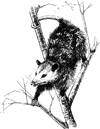Vertebrate Pest Conference: Proceedings

Vertebrate Pest Conference Proceedings: 16th (1994)
Date of this Version
February 1994
Document Type
Article
Abstract
Predators play important roles in the ecology, epidemiology, and surveillance of plague in the United States. Most predators are accidental hosts of plague and, with the possible exception of grasshopper mice (Onychomys spp.), are not important sources of infection for feeding fleas. However, predators undoubtedly do play an important role in the natural cycle of plague by transporting infected fleas between different populations of plague-susceptible rodents. Predators are known to be at least accidental hosts for 40 of the 50 flea species that have been found to be naturally infected with plague in the U.S. Carnivores, including domestic cats, also play an important epidemiological role and have been sources of infection for 24 human plague cases since 1970. Serosurveillance of rodent-consuming carnivores is currently the most cost-effective method of monitoring plague in the western U.S. During the 1990s, these surveys have allowed CDC and other public health agencies to both identify plague risks for humans living in endemic regions and document the spread of plague into areas where it had not been identified previously.

